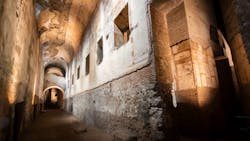A Nero pleasure palace, long buried, comes back to light
An expansive pleasure palace of Emperor Nero’s known as the Domus Aurea was such an embarrassment to his successors that they filled it with earth and built over it. It was eventually forgotten for centuries, until a man literally fell into it through a hillside in the fifteenth century, according to historical accounts.
These days it’s one of Rome’s tourist attractions. The Domus Aurea — Latin for “Golden House” as its opulence included a golden dome — has opened and closed to the public several times over the decades. Now, the sprawling underground symbol of decadence is more visible than ever, because German architectural LED lighting company Erco has relit the rooms, vaults, and passageways, working with Milan-based architects Stefano Boeri.
The new lights and a steel walkway allow visitors to amble from space to space of the palace, which dates back to 64 AD. Stops along the way include the spectacular Octagonal Room, an eight-sided domed hall that in its day Nero used for dining and entertainment — yes, orgies were part of the package — making use of its nooks, alcoves, waterfall, rotating floor, and a lattice ceiling that showered perfume and petals on guests.
Being under meters of mud, the Domus Aurea contends constantly with water, corrosive salts, and tree roots — presenting unique lighting challenges that Erco met using its Kona range of outdoor projector LED lights, which it describes as “corrosion resistant.”
Erco intentionally kept luminance levels low in many of the palace’s locations, in order to recreate the sense of torchlight that not only lit the place in Nero’s time but that re-discoverers — such as painter Raphael — would have used in the fifteenth century to view the palace, its frescoes, and other artwork. For similar reasons, Erco set color temperature at a warm 2700K, except in areas where it intentionally wanted to recreate daylight scenarios that would have featured in Nero’s time before the mudslingers took over.
“Although the new scheme has a much lower luminance level than the original, the vastly improved light distribution now reaches the ceiling and has brought to light paintings that had not been seen before,” Lüdenscheid-based Erco said in a press release announcing the project.
In some areas, Erco uses both warm and cool light. For example, in part of a 130m-long corridor known as the Criptoporticus, sensors and Casambi Bluetooth controls switch on warm light to evoke wall torches as people approach. Those lights then switch off and give way to cooler 4000K lights mounted higher up in window niches, evoking a daytime scene.
Erco uses even cooler 5000K Bluetooth-controlled tunable lighting to convey the sense of a water cascade that flowed in a temple known as the Nymphaeum of Polyphemus (a Nymphaeum is a shrine to nymphs).
Other touches include Erco Lightgap indoor wall washers in the Octagonal Room, where six outdoor Kona luminaires point down from the oculus to mimic the daylight that would have shone through the opening before it was buried.
Architect Stefano Borghini points out in an Erco YouTube video that the Bluetooth controls also ensure that artificial light shines only when needed, which helps minimize damage, including mold, that light and high humidity can impose on structures and artwork. In other gallery, museum, and historical lighting projects, Erco has also taken care when working with designers and specifiers to provide precise light distribution and minimize the impact of existing structures and features. Recently, the company delivered glare-reducing luminaires in a German theater to ensure patrons’ visual comfort.
“We have also set up dynamic scenes along the new route that the guide can activate during the tour and illustrate the movement to demonstrate the effects of natural light, thereby giving visitors an impression of the character of the building,” Borghini says.
Alfonsina Russo, director of Rome’s Parco Archeologico del Colosseo which oversees attractions in the area including the Colosseum, likes what she can now see better than before at the Domus Aurea.
The new lighting “recreates the skill of Nero’s architects in harnessing daylight and directing it into the various spaces,” she says in the video.
Emperor Trajan and other Nero successors will have to try harder next time to sequester the debauched man’s haunts out of public view.
MARK HALPER is a contributing editor for LEDs Magazine, and an energy, technology, and business journalist ([email protected]).
For up-to-the-minute LED and SSL updates, why not follow us on Twitter? You’ll find curated content and commentary, as well as information on industry events, webcasts, and surveys on our LinkedIn Company Page and our Facebook page.

Mark Halper | Contributing Editor, LEDs Magazine, and Business/Energy/Technology Journalist
Mark Halper is a freelance business, technology, and science journalist who covers everything from media moguls to subatomic particles. Halper has written from locations around the world for TIME Magazine, Fortune, Forbes, the New York Times, the Financial Times, the Guardian, CBS, Wired, and many others. A US citizen living in Britain, he cut his journalism teeth cutting and pasting copy for an English-language daily newspaper in Mexico City. Halper has a BA in history from Cornell University.








